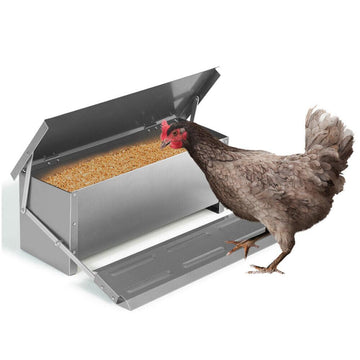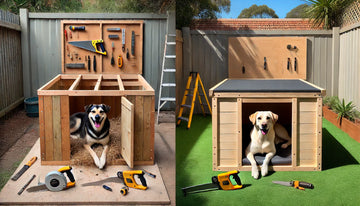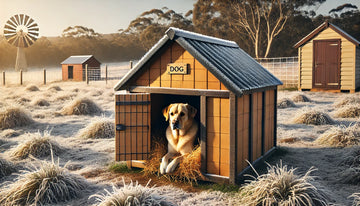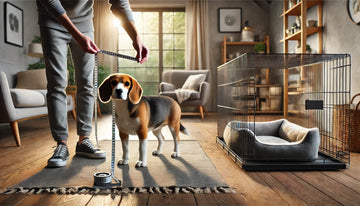Introduction
Raising backyard chickens is a rewarding experience—there's nothing quite like collecting fresh eggs from your own hens. But let’s be honest, the daily task of feeding them can become a bit of a chore. Between work, school runs, unpredictable Aussie weather, and holidays, it's easy to miss a feed or deal with wasted food. And let’s not even get started on the real freeloaders: rats, mice, and even possums helping themselves to your chicken feed when you're not around.
This is where automatic chicken feeders step in as potential lifesavers. Designed to streamline feeding while keeping pests and the elements out, they promise a hassle-free experience for chicken keepers. But do they actually live up to the hype? In this guide, we’ll take a deep dive into how automatic feeders work, what features to look out for, which models suit your backyard, and the undeniable benefits they bring to Aussie homes with a flock.
Let’s crack into it, shall we?
What Is an Automatic Chicken Feeder?
When you think of a chicken feeder, you might picture a basic plastic bowl or an open trough filled with grains. But automatic feeders? They're next level. These feeders are built to release food in a controlled way, usually only when your chickens want it—keeping the food safe, clean, and out of reach from unwanted guests.
Treadle Feeders vs. Gravity Feeders
There are two main types of automatic feeders used in Aussie backyards: treadle feeders and gravity feeders.
-
Treadle Feeders open when a chicken steps on a small platform. It’s like a secret doorway to food. When the hen steps on the treadle, the lid lifts, revealing the feed. Step off, and it closes—keeping rodents and birds at bay. Smart, right?
-
Gravity Feeders, on the other hand, work by allowing food to drop into a tray as chickens peck at it. They're often covered but don’t offer the same level of rodent-proofing as a treadle model.
Each has its place. If you’re dealing with smart rodents or large flocks, a treadle feeder offers better security. If simplicity and budget are top priorities, gravity feeders do the job with less fuss.
Key Features of Automatic Feeders
Not all feeders are created equal, especially in a land like Australia. The harsh sun, sudden downpours, and relentless pests mean Aussie chicken keepers need equipment that’s tough and reliable. Here’s what to look for:
-
Self-Dispensing Mechanics: The best feeders only release feed when a chicken interacts with it, keeping it secure from pests and minimizing waste.
-
Weather-Resistant Design: Look for models made from rust-proof aluminum or UV-stabilised plastics that can handle the intense sun, rain, and even hail.
-
Step-Lid Access (Treadle Feeders): Essential for pest control. Keeps feed covered unless your chicken is standing on it.
-
Rodent-Proof Construction: Rats are smart. They’ll chew, climb, and sneak their way in. Quality feeders have tight seals, heavy-duty build, and clever mechanics to stop freeloaders in their tracks.
Why Aussie Chicken Keepers Need Specific Features
Backyard chooks in Australia face unique challenges. In summer, you’ve got sweltering 40°C days that can spoil feed quickly. In winter, it’s rain, mud, and cold winds. Then there’s the ever-present threat of rodents, cockatoos, and possums—all more than happy to pinch your chook’s breakfast.
That’s why feeders built for Aussie backyards go beyond just function. They’re designed to last, handle the climate, and keep your flock fed and healthy with minimal intervention from you. Win-win, right?
Benefits of Using an Automatic Chicken Feeder
Alright, so they sound fancy. But what do automatic chicken feeders actually do for you? Let’s get into the real-world perks that make these devices a backyard essential.
🕒 Save Time and Energy
We all have busy lives, and chickens don’t take holidays. With an automatic feeder, you don’t need to be there morning and evening to top up feed. You can go away for the weekend (or even longer) knowing your hens won’t go hungry. For people balancing families, jobs, and the chaos of modern life, this peace of mind is golden.
Automatic feeders can store enough feed to last days or even weeks, depending on the size of your flock. It’s a game-changer for time management, freeing you up for more enjoyable parts of chicken keeping—like collecting fresh eggs or watching them scratch around the garden.
🐭 Rodent Protection
If you’ve ever gone out to feed your hens only to find half the feed gone—and suspicious little droppings nearby—you know the frustration of dealing with rodents. Rats aren’t just thieves; they bring disease, chew through wiring and wood, and even attack baby chicks.
Most automatic feeders, especially treadle designs, are built with rodent protection in mind. The lid mechanism is too heavy or complex for a mouse or rat to activate, meaning they go hungry while your chooks dine in peace. Some models even feature seals or barriers that block crawling pests from sneaking in.
Imagine waking up knowing the only creatures enjoying your chicken feed are the ones it’s actually meant for. Bliss.
🌧️ Feed Protection Against Weather
Nothing ruins good-quality chicken feed like a downpour or blistering sun. Wet feed molds quickly, and heat can cause spoilage or attract flies. Automatic feeders with sealed lids or hopper-style dispensers keep feed dry, cool, and clean.
That means no more soggy piles of grain and no more tossing out wasted bags because the weather turned on you. This isn’t just convenient—it’s crucial for maintaining your flock’s health. Spoiled feed can make chickens sick, affect egg production, and even attract more pests.
A well-designed feeder protects your investment in every way—saving feed, saving money, and saving your sanity.
🥚 Consistent Feeding = Happy Hens
Chickens are creatures of habit. They thrive on routine, and when they know food is reliably available, it lowers stress and boosts productivity—yes, we’re talking about egg-laying.
Automatic feeders provide that consistency. No skipped meals. No empty feeders at night. Just a regular, steady supply of food that keeps your flock well-fed and content.
Happy hens lay more eggs. It’s that simple.
💸 Reduced Feed Waste and Costs
Let’s face it—chicken feed isn’t cheap. And every bit that gets spilled, soaked, or stolen is money out of your pocket.
Automatic feeders are designed to minimize spillage. Some models even have anti-scratch trays or controlled release functions that stop hens from scattering feed everywhere (they love doing that). Less waste means more savings over time.
And when you’re buying less feed because it’s not being spoiled or stolen? That’s money you can put toward better gear, healthier supplements, or even just your next cuppa.
Which Type of Chicken Feeder Is Right for You?
With so many options out there, choosing the best automatic chicken feeder can feel a bit overwhelming. But don’t worry—it all comes down to understanding your flock, your space, and your budget. Let’s break it down to help you find the right fit for your backyard.
✅ Consider Your Flock Size
The size of your flock should be the first factor you consider. If you’ve got a small urban backyard with 3–5 hens, you won’t need a giant commercial-grade feeder. A compact treadle or gravity model with a 5–10kg feed capacity will do the trick.
On the flip side, if you’re managing a larger flock on a hobby farm, a high-capacity feeder that can hold 20–30kg of feed will save you from constantly refilling. You might even consider multiple feeders placed around the coop to ensure every bird gets a fair peck.
Smaller feeders are lighter and easier to clean. Larger ones reduce your daily workload but may need sturdier setup and better placement to avoid tipping or crowding.
✅ Urban vs. Rural Setup
Where you live plays a huge role in feeder choice. Urban chicken keepers need to think about things like:
-
Neighbours: Treadle feeders are quieter and less likely to cause early morning chicken chaos.
-
Pests: Urban areas might have more issues with pigeons and rats.
-
Space: A compact design is ideal for tighter coops and runs.
For rural or hobby farm setups, you’ve got more room to work with—but also more wild visitors. Possums, bush rats, cockatoos, and even snakes might show up for a snack. A heavy-duty treadle feeder with strong lids and rodent-proof sealing is essential here.
✅ Budget vs. Premium Options
Here’s the deal—spending a little more upfront can save you loads in the long run. That said, your budget matters.
-
Budget Feeders (Under $100): These are typically basic gravity models made of plastic or lightweight metal. Great for getting started but may wear out faster or offer limited pest protection.
-
Mid-Range Feeders ($100–$200): These often include well-designed treadle systems with stronger construction, decent capacity, and some weatherproofing.
-
Premium Feeders ($200+): Think large capacity, galvanized or powder-coated steel, rodent-proof design, UV-resistant build, and excellent durability—ideal for Aussie conditions.
✅ Pros and Cons Table
| Feeder Type | Pros | Cons |
|---|---|---|
| Gravity Feeder | Simple, affordable, easy to use | Prone to spillage and pest access |
| Treadle Feeder | Rodent-proof, weather-resistant, secure | Chickens need training, higher upfront cost |
| Hopper Feeder | Great for larger flocks, high capacity | Bulky, more expensive |
Tips for Setting Up Your Chicken Feeder
Once you’ve chosen the right feeder, proper setup makes all the difference. It’s not just about plonking it down and walking away—you need to consider positioning, training, and upkeep to get the most out of your investment.
Where to Place It
Placement matters—a lot. A poorly positioned feeder can lead to wet feed, messy surroundings, or accessibility issues for your hens.
-
Keep it Dry: Choose a covered or sheltered area to protect against rain. Under a coop overhang, inside a chicken run, or in a shaded spot works well.
-
Flat Ground is Key: For treadle feeders, a level surface ensures the lid opens and closes smoothly. Uneven ground can throw off the weight mechanics.
-
Avoid Nesting or Pooping Zones: You don’t want your feeder becoming a perch or bathroom. Set it away from nesting boxes and roosting areas.
How to Train Your Hens to Use a Treadle Feeder
Chickens are curious but cautious. A treadle feeder may confuse or scare them at first, but with a little patience, they’ll get the hang of it quickly.
Training steps:
-
Leave the Lid Open: For the first few days, prop the lid open so they can see and peck at the feed.
-
Introduce the Treadle Slowly: Let them step on the plate while the lid is still propped open so they get used to the feel.
-
Start Partial Closure: Lower the lid partway, encouraging them to press the treadle to open it.
-
Full Closure: After 5–7 days, let the lid function normally. Most hens will have figured it out by now.
Some hens might need extra encouragement. Sprinkle a bit of feed on the treadle or gently guide them. Within a week or two, they’ll be pros.
Keeping It Clean and Maintained
Like any tool, your chicken feeder needs some TLC. A dirty or broken feeder can attract pests, spoil feed, or even injure your flock.
Basic maintenance tips:
-
Clean Weekly: Wipe down the inside and outside with warm soapy water and rinse well.
-
Inspect for Damage: Check for rust, cracks, or chew marks—especially around moving parts.
-
Top Up Feed Properly: Don’t overload it. Pour slowly and keep it dry.
-
Keep Surroundings Clean: Rake the area around the feeder to remove spilled feed or droppings.
A clean feeder is a happy feeder—and your chickens (and your wallet) will thank you.
When to Upgrade to a Larger Size
As your flock grows or you find yourself refilling feed too often, it might be time to scale up.
Signs it’s time to upgrade:
-
You're refilling every 1–2 days
-
Birds are crowding or pushing each other at feeding time
-
Your current feeder shows wear and tear
-
You're going away frequently and need more storage capacity
Consider your future plans too. Even if you only have five hens now, if you’re planning to expand, investing in a larger feeder now could save you money and hassle later.
Our Top Picks for Automatic Chicken Feeders
With so many options out there, we've narrowed it down to a few of the best automatic chicken feeders that Aussie backyard chicken keepers swear by. Whether you’re just starting or a seasoned flock master, these picks offer reliability, quality, and great value.
Best for Small Flocks: Dine-a-Chook 3.5kg Gravity Feeder
-
Why We Love It: Compact, UV-stabilised PVC, simple to install, great for 2–4 hens.
-
Best For: Urban chicken keepers or new flock owners.
-
Bonus: Built to prevent spillage and keep feed dry, even during summer storms.
Best Treadle Feeder: Grandpa’s Feeders Original
-
Why We Love It: Heavy-duty galvanized steel, rodent-proof design, lid stays shut until stepped on.
-
Best For: Pest-prone areas, medium to large flocks.
-
Bonus: Holds up to 9kg of feed, great for weekend getaways.
Best Premium Feeder: Royal Rooster Twin Feeder Set
-
Why We Love It: Twin silo design with weather-proof covers, Australian-made, no mess, no fuss.
-
Best For: Serious chicken keepers who want top quality.
-
Bonus: Includes both feed and water silos—complete feeding system.
👉 Looking for a reliable option?
Check out our full automatic chicken feeder collection — built tough for Aussie backyards.
Final Thoughts
Raising chickens should be fun, not frustrating. With the right gear in place—especially an automatic chicken feeder—you can simplify your daily routine, protect your investment in feed, and keep your flock healthy, happy, and productive. No more soggy grains after a downpour, no more frantic morning feeds, and definitely fewer run-ins with rats and other feed thieves.
The upfront cost of an automatic feeder might make some backyard keepers hesitate, but the long-term savings—in both time and money—are well worth it. Plus, your chickens will thank you. Regular, rodent-free access to clean feed can significantly improve egg production, reduce stress, and even boost the health of your hens.
If you’re serious about chicken keeping—whether it’s just a few hens in the backyard or a bustling hobby farm—investing in a good-quality automatic feeder is a no-brainer.
So, what are you waiting for? Make your life easier and your chickens happier.
FAQs
What is the best chicken feeder in Australia?
The best chicken feeder depends on your specific needs, but popular, reliable options include Grandpa’s Feeders for treadle-style and Royal Rooster for gravity-fed models. Both are designed for Aussie conditions and offer excellent pest and weather protection.
How do I keep rats out of my chicken feeder?
The most effective way is to use a rodent-proof treadle feeder. These only open when a chicken steps on the treadle plate, keeping feed sealed away from rats. Regularly clean the area around the feeder to avoid attracting pests with spilled food.
How much feed should I put in an automatic feeder?
It depends on your feeder’s capacity and flock size. A medium-sized automatic feeder usually holds 5–10kg of feed—enough for 4–6 hens for about a week. Always monitor how much your hens eat and avoid overfilling to prevent spoilage.
Can chickens learn to use a treadle feeder?
Absolutely. Most chickens pick it up within a few days. Start by leaving the lid open, gradually introducing the treadle motion. With a bit of patience and perhaps some encouragement (a little treat works wonders), your chooks will figure it out quickly.
Do automatic feeders work for all bird sizes?
Most automatic feeders are designed for standard-sized laying hens. If you have bantams or very young birds, ensure the treadle isn't too heavy or high. Some models are adjustable or come in sizes suitable for smaller breeds.





